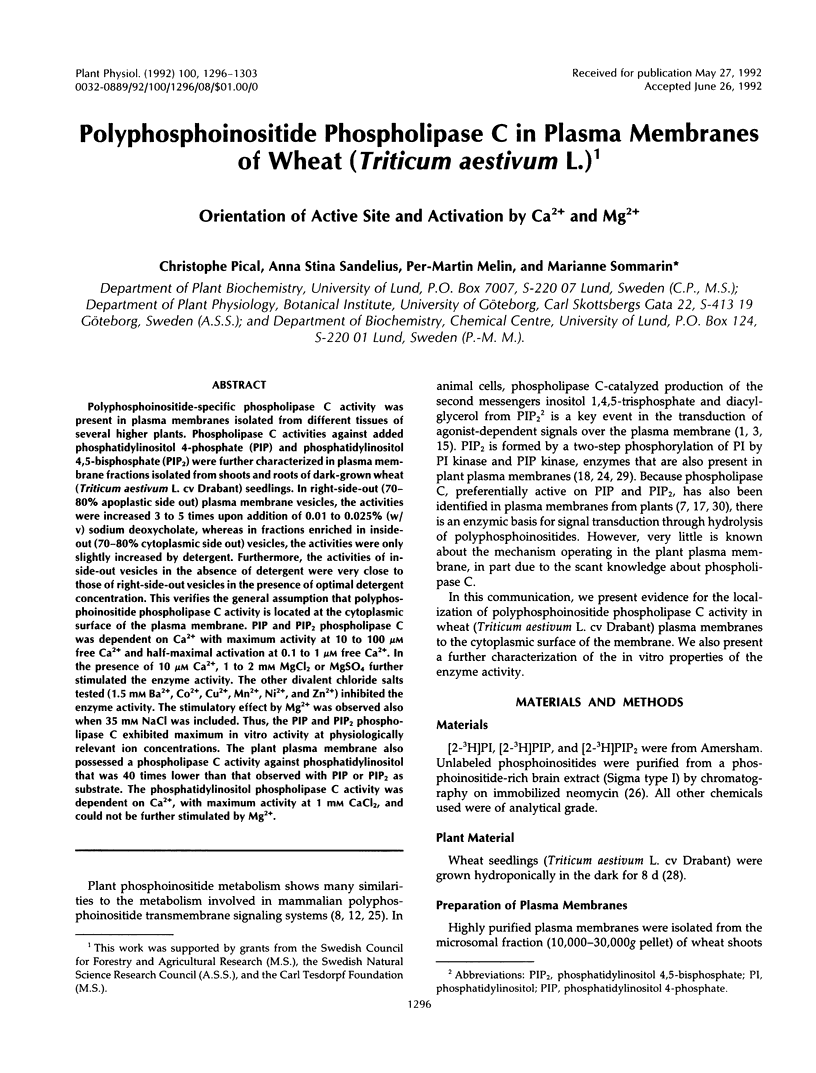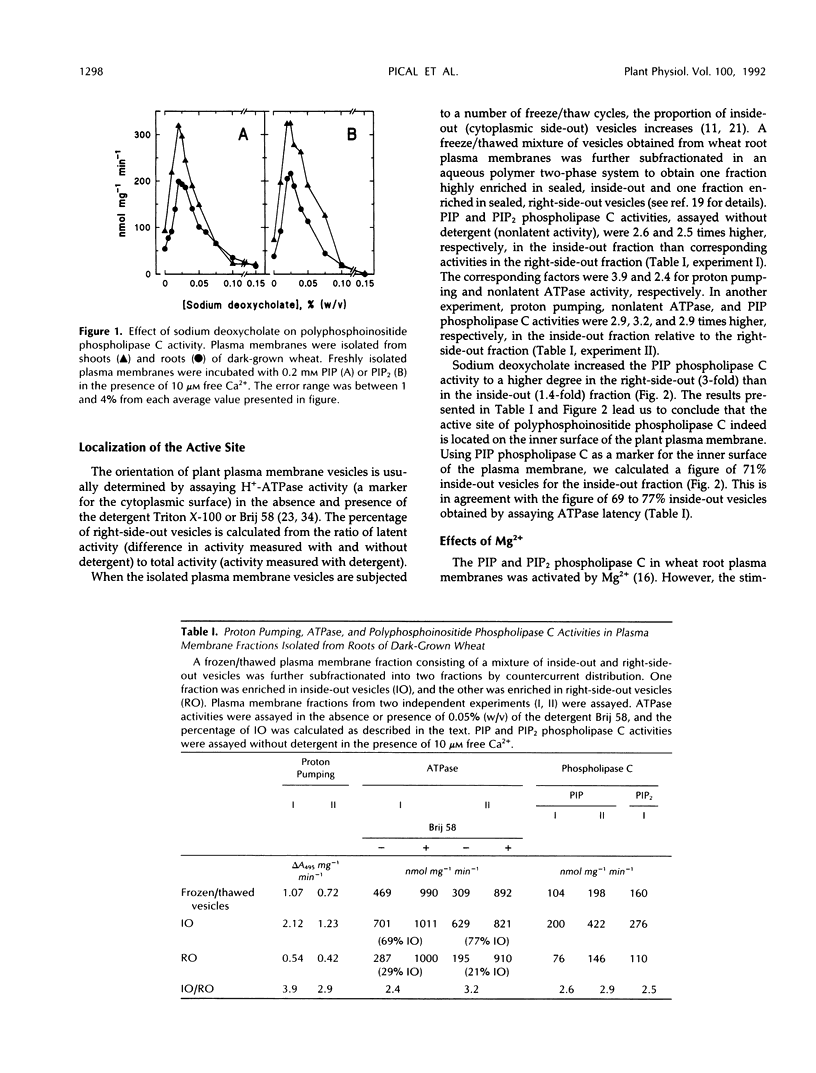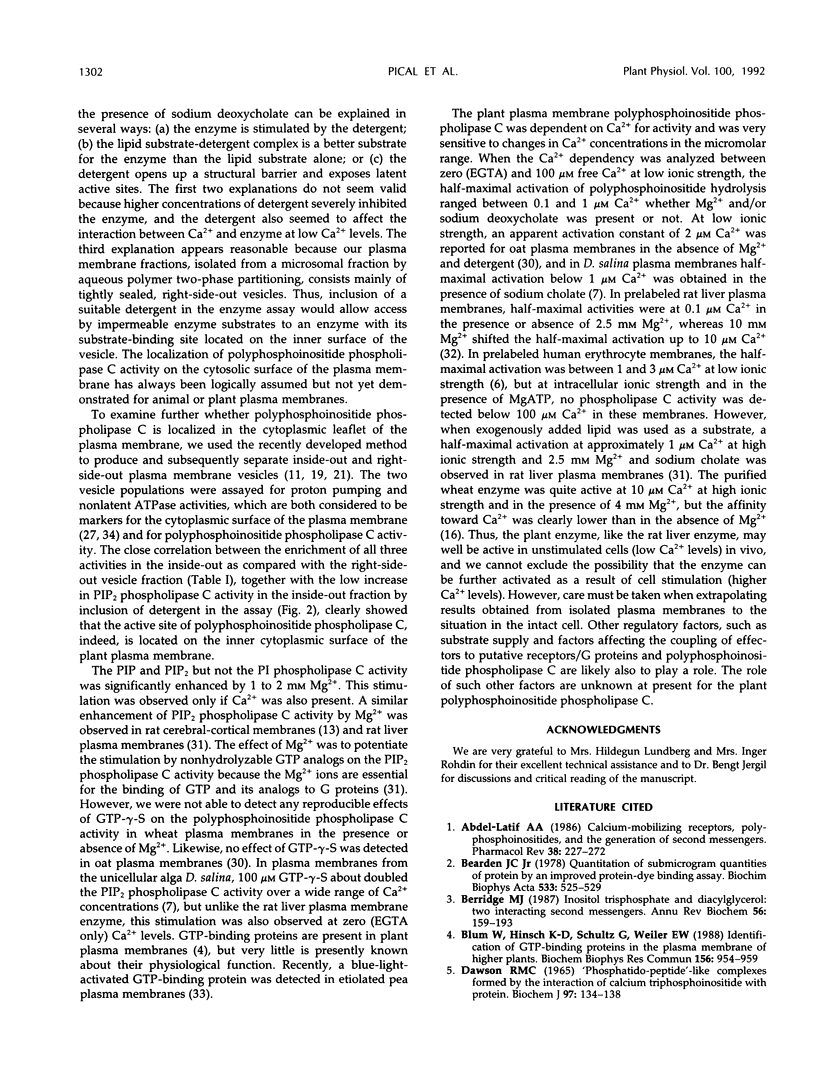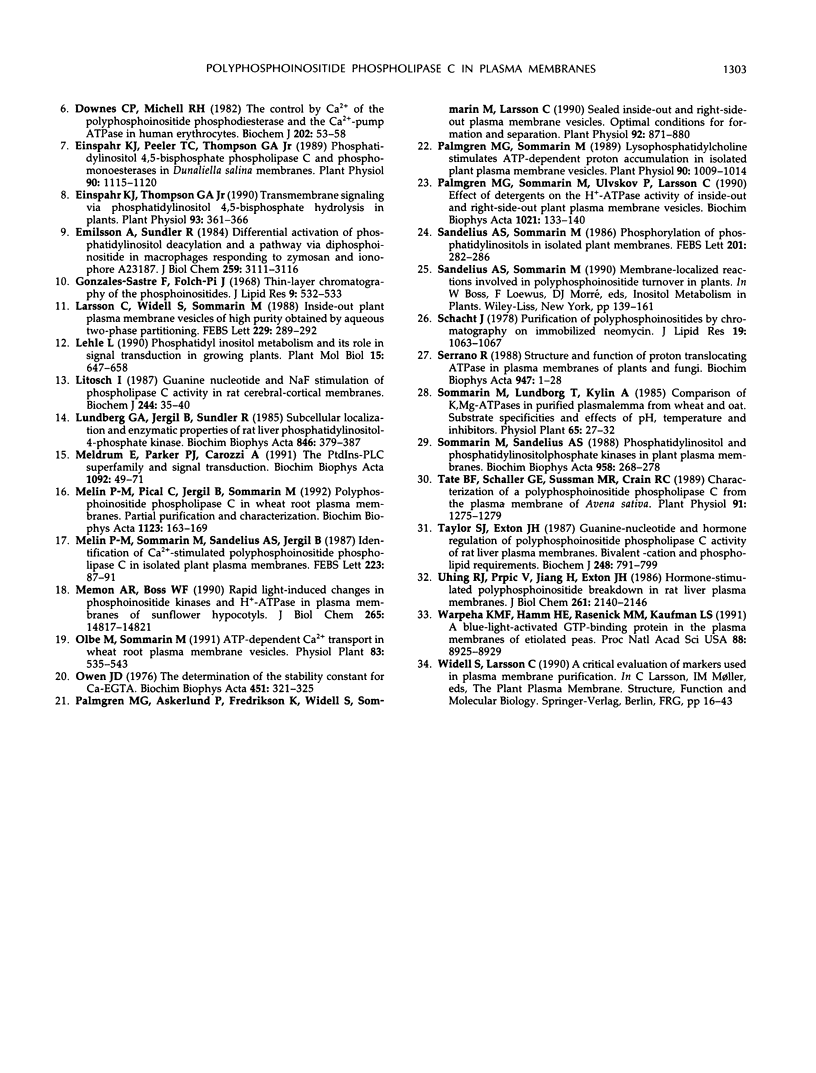Abstract
Polyphosphoinositide-specific phospholipase C activity was present in plasma membranes isolated from different tissues of several higher plants. Phospholipase C activities against added phosphatidylinositol 4-phosphate (PIP) and phosphatidylinositol 4,5-bisphosphate (PIP2) were further characterized in plasma membrane fractions isolated from shoots and roots of dark-grown wheat (Triticum aestivum L. cv Drabant) seedlings. In right-side-out (70-80% apoplastic side out) plasma membrane vesicles, the activities were increased 3 to 5 times upon addition of 0.01 to 0.025% (w/v) sodium deoxycholate, whereas in fractions enriched in inside-out (70-80% cytoplasmic side out) vesicles, the activities were only slightly increased by detergent. Furthermore, the activities of inside-out vesicles in the absence of detergent were very close to those of right-side-out vesicles in the presence of optimal detergent concentration. This verifies the general assumption that polyphosphoinositide phospholipase C activity is located at the cytoplasmic surface of the plasma membrane. PIP and PIP2 phospholipase C was dependent on Ca2+ with maximum activity at 10 to 100 μm free Ca2+ and half-maximal activation at 0.1 to 1 μm free Ca2+. In the presence of 10 μm Ca2+, 1 to 2 mm MgCl2 or MgSO4 further stimulated the enzyme activity. The other divalent chloride salts tested (1.5 mm Ba2+, Co2+, Cu2+, Mn2+, Ni2+, and Zn2+) inhibited the enzyme activity. The stimulatory effect by Mg2+ was observed also when 35 mm NaCl was included. Thus, the PIP and PIP2 phospholipase C exhibited maximum in vitro activity at physiologically relevant ion concentrations. The plant plasma membrane also possessed a phospholipase C activity against phosphatidylinositol that was 40 times lower than that observed with PIP or PIP2 as substrate. The phosphatidylinositol phospholipase C activity was dependent on Ca2+, with maximum activity at 1 mm CaCl2, and could not be further stimulated by Mg2+.
Full text
PDF







Selected References
These references are in PubMed. This may not be the complete list of references from this article.
- Abdel-Latif A. A. Calcium-mobilizing receptors, polyphosphoinositides, and the generation of second messengers. Pharmacol Rev. 1986 Sep;38(3):227–272. [PubMed] [Google Scholar]
- Bearden J. C., Jr Quantitation of submicrogram quantities of protein by an improved protein-dye binding assay. Biochim Biophys Acta. 1978 Apr 26;533(2):525–529. doi: 10.1016/0005-2795(78)90398-7. [DOI] [PubMed] [Google Scholar]
- Berridge M. J. Inositol trisphosphate and diacylglycerol: two interacting second messengers. Annu Rev Biochem. 1987;56:159–193. doi: 10.1146/annurev.bi.56.070187.001111. [DOI] [PubMed] [Google Scholar]
- Blum W., Hinsch K. D., Schultz G., Weiler E. W. Identification of GTP-binding proteins in the plasma membrane of higher plants. Biochem Biophys Res Commun. 1988 Oct 31;156(2):954–959. doi: 10.1016/s0006-291x(88)80936-7. [DOI] [PubMed] [Google Scholar]
- Dawson R. M. 'Phosphatido-peptide'-like complexes formed by the interaction of calcium triphosphoinositide with protein. Biochem J. 1965 Oct;97(1):134–138. doi: 10.1042/bj0970134. [DOI] [PMC free article] [PubMed] [Google Scholar]
- Downes C. P., Michell R. H. The control by Ca2+ of the polyphosphoinositide phosphodiesterase and the Ca2+-pump ATPase in human erythrocytes. Biochem J. 1982 Jan 15;202(1):53–58. doi: 10.1042/bj2020053. [DOI] [PMC free article] [PubMed] [Google Scholar]
- Einspahr K. J., Peeler T. C., Thompson G. A. Phosphatidylinositol 4,5-Bisphosphate Phospholipase C and Phosphomonoesterase in Dunaliella salina Membranes. Plant Physiol. 1989 Jul;90(3):1115–1120. doi: 10.1104/pp.90.3.1115. [DOI] [PMC free article] [PubMed] [Google Scholar]
- Einspahr K. J., Thompson G. A. Transmembrane Signaling via Phosphatidylinositol 4,5-Bisphosphate Hydrolysis in Plants. Plant Physiol. 1990 Jun;93(2):361–366. doi: 10.1104/pp.93.2.361. [DOI] [PMC free article] [PubMed] [Google Scholar]
- Emilsson A., Sundler R. Differential activation of phosphatidylinositol deacylation and a pathway via diphosphoinositide in macrophages responding to zymosan and ionophore A23187. J Biol Chem. 1984 Mar 10;259(5):3111–3116. [PubMed] [Google Scholar]
- Gonzalez-Sastre F., Folch-Pi J. Thin-layer chromatography of the phosphoinositides. J Lipid Res. 1968 Jul;9(4):532–533. [PubMed] [Google Scholar]
- Lehle L. Phosphatidyl inositol metabolism and its role in signal transduction in growing plants. Plant Mol Biol. 1990 Oct;15(4):647–658. doi: 10.1007/BF00017839. [DOI] [PubMed] [Google Scholar]
- Litosch I. Guanine nucleotide and NaF stimulation of phospholipase C activity in rat cerebral-cortical membranes. Studies on substrate specificity. Biochem J. 1987 May 15;244(1):35–40. doi: 10.1042/bj2440035. [DOI] [PMC free article] [PubMed] [Google Scholar]
- Lundberg G. A., Jergil B., Sundler R. Subcellular localization and enzymatic properties of rat liver phosphatidylinositol-4-phosphate kinase. Biochim Biophys Acta. 1985 Sep 30;846(3):379–387. doi: 10.1016/0167-4889(85)90009-6. [DOI] [PubMed] [Google Scholar]
- Meldrum E., Parker P. J., Carozzi A. The PtdIns-PLC superfamily and signal transduction. Biochim Biophys Acta. 1991 Mar 19;1092(1):49–71. doi: 10.1016/0167-4889(91)90177-y. [DOI] [PubMed] [Google Scholar]
- Melin P. M., Pical C., Jergil B., Sommarin M. Polyphosphoinositide phospholipase C in wheat root plasma membranes. Partial purification and characterization. Biochim Biophys Acta. 1992 Jan 24;1123(2):163–169. doi: 10.1016/0005-2760(92)90107-7. [DOI] [PubMed] [Google Scholar]
- Melin P. M., Sommarin M., Sandelius A. S., Jergil B. Identification of Ca2+-stimulated polyphosphoinositide phospholipase C in isolated plant plasma membranes. FEBS Lett. 1987 Oct 19;223(1):87–91. doi: 10.1016/0014-5793(87)80515-x. [DOI] [PubMed] [Google Scholar]
- Memon A. R., Boss W. F. Rapid light-induced changes in phosphoinositide kinases and H(+)-ATPase in plasma membrane of sunflower hypocotyls. J Biol Chem. 1990 Sep 5;265(25):14817–14821. [PubMed] [Google Scholar]
- Owen J. D. The determination of the stability constant for calcium-EGTA. Biochim Biophys Acta. 1976 Nov 18;451(1):321–325. doi: 10.1016/0304-4165(76)90282-8. [DOI] [PubMed] [Google Scholar]
- Palmgren M. G., Askerlund P., Fredrikson K., Widell S., Sommarin M., Larsson C. Sealed inside-out and right-side-out plasma membrane vesicles : optimal conditions for formation and separation. Plant Physiol. 1990 Apr;92(4):871–880. doi: 10.1104/pp.92.4.871. [DOI] [PMC free article] [PubMed] [Google Scholar]
- Palmgren M. G., Sommarin M. Lysophosphatidylcholine stimulates ATP dependent proton accumulation in isolated oat root plasma membrane vesicles. Plant Physiol. 1989 Jul;90(3):1009–1014. doi: 10.1104/pp.90.3.1009. [DOI] [PMC free article] [PubMed] [Google Scholar]
- Palmgren M. G., Sommarin M., Ulvskov P., Larsson C. Effect of detergents on the H(+)-ATPase activity of inside-out and right-side-out plant plasma membrane vesicles. Biochim Biophys Acta. 1990 Jan 29;1021(2):133–140. doi: 10.1016/0005-2736(90)90025-j. [DOI] [PubMed] [Google Scholar]
- Schacht J. Purification of polyphosphoinositides by chromatography on immobilized neomycin. J Lipid Res. 1978 Nov;19(8):1063–1067. [PubMed] [Google Scholar]
- Serrano R. Structure and function of proton translocating ATPase in plasma membranes of plants and fungi. Biochim Biophys Acta. 1988 Feb 24;947(1):1–28. doi: 10.1016/0304-4157(88)90017-2. [DOI] [PubMed] [Google Scholar]
- Tate B. F., Schaller G. E., Sussman M. R., Crain R. C. Characterization of a Polyphosphoinositide Phospholipase C from the Plasma Membrane of Avena sativa. Plant Physiol. 1989 Dec;91(4):1275–1279. doi: 10.1104/pp.91.4.1275. [DOI] [PMC free article] [PubMed] [Google Scholar]
- Taylor S. J., Exton J. H. Guanine-nucleotide and hormone regulation of polyphosphoinositide phospholipase C activity of rat liver plasma membranes. Bivalent-cation and phospholipid requirements. Biochem J. 1987 Dec 15;248(3):791–799. doi: 10.1042/bj2480791. [DOI] [PMC free article] [PubMed] [Google Scholar]
- Uhing R. J., Prpic V., Jiang H., Exton J. H. Hormone-stimulated polyphosphoinositide breakdown in rat liver plasma membranes. Roles of guanine nucleotides and calcium. J Biol Chem. 1986 Feb 15;261(5):2140–2146. [PubMed] [Google Scholar]
- Warpeha K. M., Hamm H. E., Rasenick M. M., Kaufman L. S. A blue-light-activated GTP-binding protein in the plasma membranes of etiolated peas. Proc Natl Acad Sci U S A. 1991 Oct 15;88(20):8925–8929. doi: 10.1073/pnas.88.20.8925. [DOI] [PMC free article] [PubMed] [Google Scholar]


